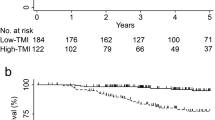Abstract
To evaluate the utility of c-erbB-2, carcinoembryonic antigen (CEA) and CA 15.3 in the early diagnosis of recurrence, serial serum determinations of these antigens were performed in 200 patients (follow-up 1-4 years, mean 2.2 years) with primary breast cancer and no evidence of residual disease (NED) after radical treatment (radical mastectomy or simple mastectomy and radiotherapy). Eighty-nine patients developed metastases during follow-up. C-erbB-2, CEA and CA 15.3 were elevated (> 20 U ml-1, > 10 ng ml-1 or > 60 U ml-1 respectively) before diagnosis in 28%, 30% and 47% of the 89 patients with recurrence, with a lead time of 4.5 +/- 2.4, 4.9 +/- 2.4 and 4.8 +/- 2.4 months respectively. Tumour marker sensitivity was clearly related to the site of recurrence, with the lowest sensitivity found in locoregional relapse and the highest in patients with liver metastases. When patients with locoregional recurrences were excluded, sensitivity improved: 31% (c-erbB-2), 33% (CEA) and 56% (CA 15.3), with 76% having at least one of the three tumour markers. C-erbB-2 sensitivity in early diagnosis was significantly higher in patients with c-erbB-2 overexpression in tissue (8/10, 80%) than in those without overexpression (1/30, 3.3%) (P = 0.0001). Likewise, higher levels of both, c-erbB-2 and CA 15.3 at diagnosis of recurrence, higher sensitivity in early diagnosis of relapse and a higher lead time were found in PR+ patients (CA 15.3, P < 0.0001) or in PR- patients (c-erbB-2, P = 0.009). Specificity of the tumour markers was 100% for all three markers (111 NED patients). In conclusion, c-erbB-2 is a useful tool for early diagnosis of metastases, mainly in those patients with c-erbB-2 overexpression in tissue. Using all three markers simultaneously it is possible to increase the sensitivity in the early diagnosis of recurrence by 11.2%.
This is a preview of subscription content, access via your institution
Access options
Subscribe to this journal
Receive 24 print issues and online access
$259.00 per year
only $10.79 per issue
Buy this article
- Purchase on Springer Link
- Instant access to full article PDF
Prices may be subject to local taxes which are calculated during checkout
Similar content being viewed by others
Author information
Authors and Affiliations
Rights and permissions
About this article
Cite this article
Molina, R., Jo, J., Zanón, G. et al. Utility of C-erbB-2 in tissue and in serum in the early diagnosis of recurrence in breast cancer patients: comparison with carcinoembryonic antigen and CA 15.3. Br J Cancer 74, 1126–1131 (1996). https://doi.org/10.1038/bjc.1996.501
Issue Date:
DOI: https://doi.org/10.1038/bjc.1996.501
This article is cited by
-
Imbalance of Circulating Follicular Regulatory and Follicular Helper T Cell Subpopulations Is Associated with Disease Progression and Serum CYFRA 21-1 Levels in Patients with Non-small Cell Lung Cancer
Current Medical Science (2024)
-
Serum HER2/ECD value in stage I and II early breast cancer – need of a lower cut-off?
Wiener klinische Wochenschrift (2011)
-
Evaluation of tumor markers (HER-2/neu oncoprotein, CEA, and CA 15.3) in patients with locoregional breast cancer: prognostic value
Tumor Biology (2010)
-
Serum epidermal growth factor receptor and HER2 expression in primary and metastatic breast cancer patients
Breast Cancer Research (2007)



